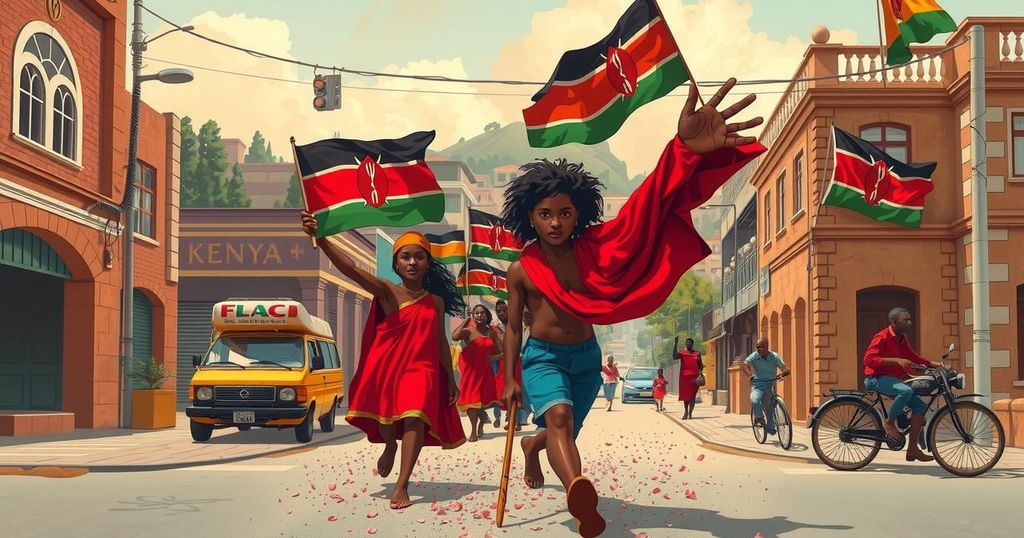Refocusing the Resistance Movement in Kenya: Beyond GenZ to the Working Class
The resistance movement in Kenya, particularly through GenZ efforts, highlights the urgent need for a long-term commitment to fighting the government led by Ruto. This movement struggles against significant obstacles due to a lack of ideological clarity and organized support among workers and peasants. The underlying tensions in the country suggest potential larger forces for change, raising critical questions about the future trajectory of resistance in Kenya.
The focus on GenZ and their participation in the RutoMustGo resistance movement in Kenya is noteworthy, as they embody visible resistance over the past year. However, resistance movements of this nature tend to be ephemeral and lack the longevity required for sustained momentum. Despite this, their efforts contribute to the broader struggle against comprador governments and foreign interests, fostering political awareness and class consciousness within the populace.
It is crucial to recognize that expecting a swift overthrow of President Ruto is unrealistic. The resistance movement should adopt a long-term perspective and organize for enduring struggle. There is a significant risk of isolation from the regime, leading to diminished support from their allies and sympathizers over time.
Historical events illustrate that the resistance failed to maintain prolonged street protests. An analytical approach is necessary to comprehend the dynamics between the ruling government and the opposition, as addressed previously: “In the final analysis, Ruto has power — political power… that is difficult to match for the resistance.”
Moreover, the opposition currently lacks the backing of organized labor and peasant movements, leaving them vulnerable to isolation and potential harm. The resistance faces compounded challenges not only from state repression but also in securing their daily livelihoods. Thus, they are left without an organized defense against Ruto’s calculated efforts to undermine them.
A significant shortcoming of the resistance lies in its ambiguous ideological framework. Unlike the historical Mau Mau movement, which had clear objectives of “Land and Freedom,” the contemporary resistance has not articulated a coherent vision for Kenya post-Ruto. This absence prevents the mobilization of broader support from workers and peasants.
Unity among the working class and marginalized individuals is vital for overcoming the current regime. While there is a dearth of a prominent working-class movement opposing capitalism, latent resistance among workers and peasants exists but is suppressed by the ruling elite. There is a pressing need for a comprehensive class analysis to bridge the gap in understanding the underlying power dynamics in the country.
The government’s understanding of the silent class struggle further complicates matters, leading to systematic efforts to isolate active participants in this struggle. On social media, instances of unrest reveal the deep-seated grievances present in communities:
– Protests erupt in locations such as Marengo and Pumwani following police violence, highlighting community frustrations.
– Reports indicate youth engaging in confrontations with law enforcement, evidenced by the burning of police stations and escalating tensions across various neighborhoods.
Currently, legitimate opposition is suppressed in Kenya, with the Constitution frequently disregarded and court rulings ignored. Workers and peasants face significant barriers in forming independent unions and reclaiming their land. Consequently, the marginalized have turned to resistance actions, despite potential repercussions. While ruling elites might overlook these forms of defiance due to their privileged positions, it is the working populace who suffer the consequences of systemic injustices.
Though the spotlight may be on GenZ and the RutoMustGo mobilization, it is essential to remain aware of the larger, potentially transformative forces simmering beneath the surface. As these forces awaken, they may catalyze significant change toward liberation or further instigate chaos, contingent upon the actions of imperialist interests.
In summary, the focus on the RutoMustGo movement captures a significant, albeit initially fleeting, form of resistance among Kenyans, particularly youth. However, for sustained impact and long-term liberation from oppressive systems, there is an urgent need for organizational unity, a clear ideological framework, and active support from the working-class. As tension escalates and internal struggles persist, a larger, dormant force for change may emerge, offering a path toward either liberation or increased turmoil, influenced by external forces.
Original Source: countercurrents.org




Post Comment